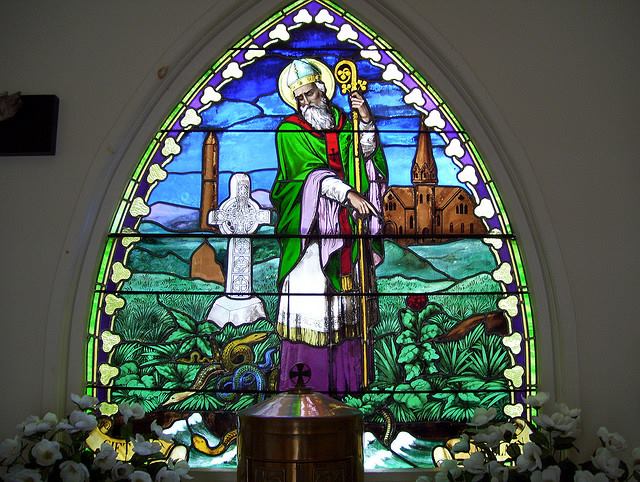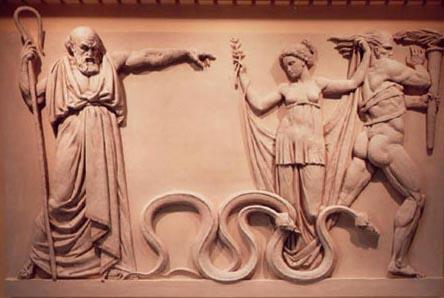St. Patrick’s Day is just around the corner and this weekend Academie Duello will be celebrating with CelticFest Vancouver. This Irish national holiday is celebrated in more countries around the world than any other national holiday. Countries such as Canada, Australia, New Zealand, Germany, America and the U.K. are all known to raise a glass of dyed-green beer on March 17th -- and subsequently, these countries are also known to have the most cases of sick days called into work on March 18th.
Despite so many countries and people celebrating St. Patrick's Day, not many people know much about the holiday, or about the man for whom it is named. Often when you ask what it's all about, responses range from something along the lines of “St. Patrick was the guy who got rid of all the snakes in Ireland,” to “it’s about celebrating Ireland and Irish culture.” But who was St. Patrick, how did he become associated with the country of Ireland, and why has he come to represent the most widely internationally celebrated national holiday?
The Origins of Saint Patrick
The man who would come to be known as St. Patrick was neither Irish nor originally from Ireland. Patrick was born into a wealthy Roman-British family who owned a decent chunk of property and slaves off the coast of modern day England. He was born into privilege being the son (and grandson!) of well-off deacons and priests within the powerful Roman Catholic Church. His father was also a decurion — that is to say, an official in the provisional Roman government. This meant that Patrick and his ancestors were Roman citizens — which gave him and his family a badge of status and nobility. However this life of luxury was interrupted when Patrick was a teenager.
At the age of 16 Patrick was taken by Irish raiders and made to work as a herdsman in what is now known as County Antrim in Northern Ireland. Raids like this were somewhat common at the time. As the Roman Empire tried to spread itself even further than the shores of Britain, the Irish fought back against any Roman attempts at settlement. One method of resistance employed by the Irish was crossing the Irish Sea to sack the British settlements that could send potential Roman conquerers over to Ireland.
Patrick spent about six years in captivity working the fields of Antrim before the opportunity came for him to make an escape. He traveled down to a port where he found passage on ship and made his way back home to Roman Briton. A few years after his return he set off to Gaul to undertake his holy studies under the tutelage of St. Germanus. This town now bears the modern name of St. Patrice in France.
Patrick soon rose to be a star pupil of Germanus who decided to take his student back to England in order to snuff out the teachings of a “heretic” named Pelagius. Pelagius believed in free will and that people could attain salvation through our own efforts without God's help. Pelagius preached that the image of God was within us, completely separated from the help of the Holy Spirit, the grace of the living God. This is why he was branded a heretic and why St. Germanus could not allow him to continue his teachings. It was during this time that Patrick began to gain the first-hand experience that would eventually lead him back to Ireland but this time, not as a captive, but as an ordained priest and with a few dozen missionaries by his side.
But What -- Or Who -- Were The Snakes?
It is said that it was St. Patrick who drove the snakes out of Ireland -- quite an incredible feat since all evidence shows that post-glacial Ireland never had snakes! So what could it mean when the legends say that he stamped his staff on the ground and rid Ireland of the snakes? Before Christianity began to spread into Ireland, the Druids were the leading religious figures in Ireland. One of the symbols of the Druids was the snake and it was often tattooed on the arms of Druids, bards and ovates. In Christianity, the snake symbolized evil and the Devil -- not unlike the snake that tempted Eve in the garden of Eden. During the seventh century, the Christian Church taught its missionaries that if they could not convert any natives willingly, they were to use any means necessary to convert the nonbelievers by force. This often meant using brutality, bribes and blackmail. Unfortunately the holy Roman Church was known -- like any political or religious power -- to sometimes to get what they wanted in unsavory ways.
Controversy: Money & Women
There is also historical evidence of charges made against Patrick by his fellow Christians at a trial. What these charges were is unclear in the few surviving documents from this case. However, there is a letter written by by Patrick from that trial where he says that he returned the gifts which wealthy women gave him; he states that he did not accept payment for baptisms, nor for ordaining priests. It has been concluded, therefore, that Patrick was likely accused of some sort of financial impropriety, and perhaps of having obtained his bishopric (the title of bishop) in Ireland with personal gain in mind. It might sound shocking to think of a holy man as being fuelled by politics and wealth, but when we look back in history this was not uncommon within the Catholic Church.
Patrick was also known for converting wealthy women, many of whom even became nuns and gave what wealth they had to the founding of his new Christian communities. Furthermore, there were rumours of Patrick having taken on more than a few rich widows as lovers -- but these claims have never been verified. We tend to have a clouded idea of the purity and chastity of the ancient Christian Church, yet when we actually study history it is not uncommon to find stories of lust, power grabs, political gain and blackmail.
In Conclusion
Like any famous figure from history, it is important to remember that the person is a human -- with human faults and imperfections. We often sensationalize the deeds (historical or apocryphal) of others and fact becomes embellished, stories are forgotten and reality begins to bleed into legend and myth. St. Patrick was just a man, and one who probably had no idea that centuries after his death his name would not only be known worldwide but also pretty much entirely within the context of the country and people that once kidnapped him and placed him into slavery and service. As you go out and celebrate St. Patrick's Day, remember that there is more behind the holiday -- and the man it is named after -- than just dressing up and green clothing and drinking beer. But please, do enjoy doing just that, albeit responsibly.

